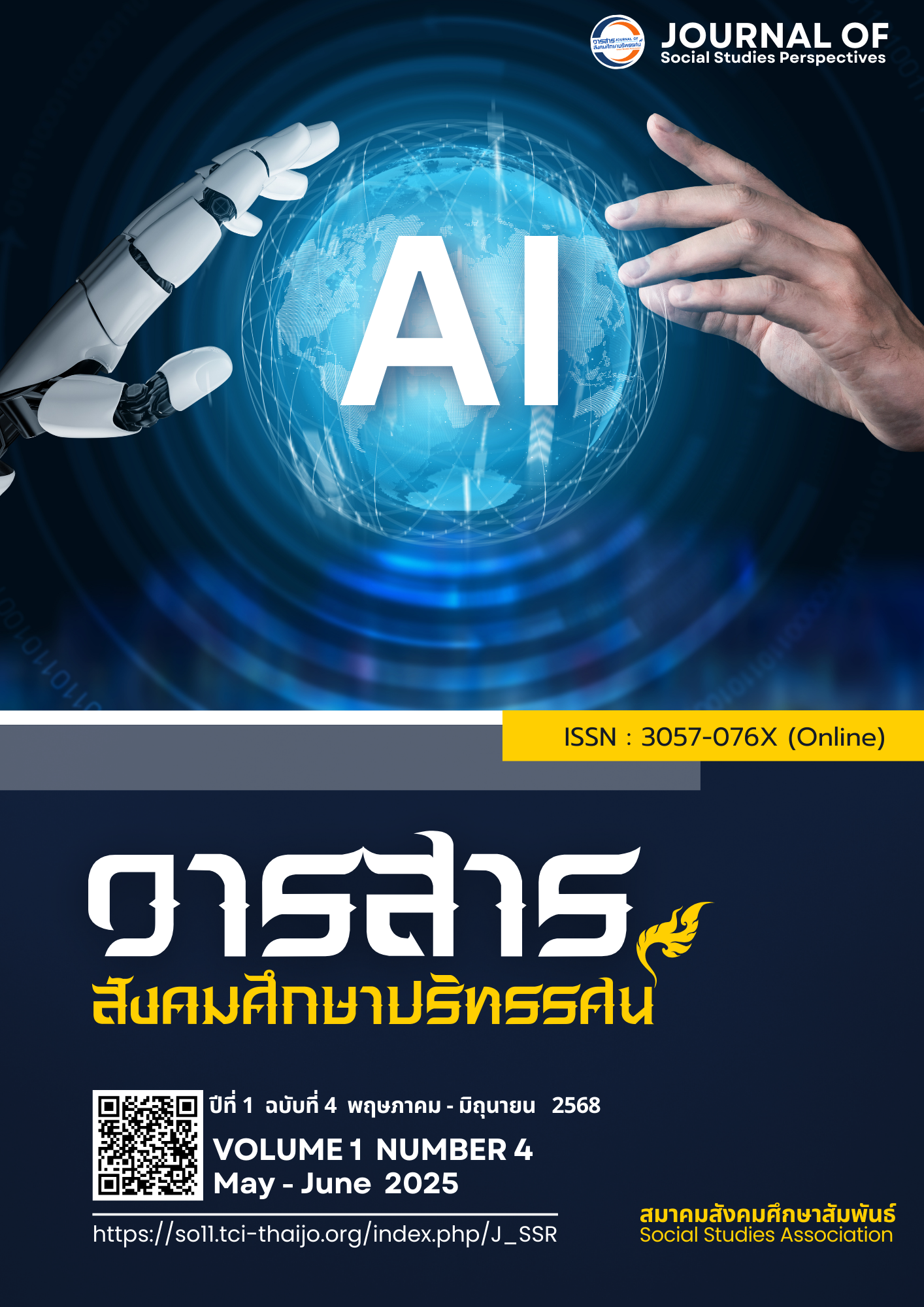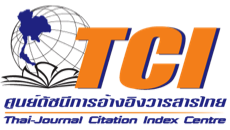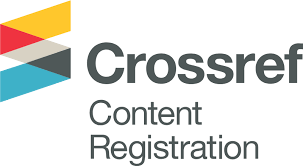การพัฒนาและกำหนดคะแนนจุดตัดของมาตรวัดความฉลาดทางอารมณ์ของพนักงานมหาวิทยาลัยเทคโนโลยีพระจอมเกล้าพระนครเหนือ
DOI:
https://doi.org/10.64186/jsp1634คำสำคัญ:
มาตรวัดความฉลาดทางอารมณ์, คะแนนจุดตัด, พนักงานมหาวิทยาลัยบทคัดย่อ
บทความวิจัยนี้มีวัตถุประสงค์ 1) เพื่อพัฒนาตรวจสอบคุณสมบัติทางจิตมิติของมาตรวัดความฉลาดทางอารมณ์ของพนักงานมหาวิทยาลัยเทคโนโลยีพระจอมเกล้าพระนครเหนือ และ 2) กำหนดคะแนนจุดตัดของมาตรวัดความฉลาดทางอารมณ์ของพนักงานมหาวิทยาลัยเทคโนโลยีพระจอมเกล้าพระนครเหนือเป็นการวิจัยเชิงปริมาณได้ศึกษาแนวคิดการวัดความฉลาดทางอารมณ์ของ Goleman (1995) เป็นกรอบการวิจัย กลุ่มตัวอย่างการวิจัยคือพนักงานมหาวิทยาลัยเทคโนโลยีพระจอมเกล้าพระนครเหนือ จำนวน 150 คน ใช้วิธีกำหนดขนาดตัวอย่างด้วยโปรแกรมสำเร็จรูปและการสุ่มอย่างง่าย เครื่องมือที่ใช้ในการวิจัยมี 1 ชนิดคือมาตรวัดความฉลาดทางอารมณ์แบบมาตรประมาณค่า 5 ระดับ จำนวน 36 ข้อ วิเคราะห์ข้อมูลโดยใช้สถิติพื้นฐาน ผลการวิจัยพบว่า
- มาตรวัดความฉลาดทางอารมณ์มีความตรงเชิงเนื้อหา มีค่าอำนาจจำแนกอยู่ในระดับปานกลาง ถึงระดับสูง มีค่าความเชื่อมั่นอยู่ในระดับสูงและโมเดลความฉลาดทางอารมณ์มีความสอดคล้องกลมกลืนกับข้อมูลเชิงประจักษ์ (IOC=.67-1.00, r=.537-762, 𝛼=.953
, (4)=4.62, p-value=.328, CFI=.999, TLI=.997, RMSEA=.0322)
- มาตรวัดความฉลาดทางอารมณ์มีจุดตัด 3 จุดแบ่งระดับความฉลาดทางอารมณ์ออกเป็น 4 ระดับคือ 1) เตรียมความพร้อมที่จะมีความฉลาดทางอารมณ์ 2) เริ่มต้นมีความฉลาดทางอารมณ์ 3) มีความฉลาดทางอารมณ์ และ 4) มีความฉลาดทางอารมณ์สูง
เอกสารอ้างอิง
Athit, T. (2024). PERMA theory: The key to a happy organization. Journal of Social Studies,
(1), 78–88. Retrieved from https://so11.tci-thaijo.org/index.php/J_SSR/article/view/1070
Bar-On, R. (2011). The BarOn model of social and emotional intelligence
(ESI). Psicothema, 18(2), 13-25.
Buddhiwong, C., & Banphai, K. (2023). Managing organizations with modern techniques.
Journal of Management and Sustainable Development, 1(1), 69–84. Retrieved from https://so15.tci-
thaijo.org/index.php/jamsd/article/view/35
Butsangkrod, K., & Chaloemwongsawech, W. (2022). Factors affecting emotional intelligence
of teachers in the Khon Kaen Primary Education Service Area Office 4. Journal of
Academic and Research, Northeastern University, 12(1), 273–287. Retrieved from https://so04.tci-
thaijo.org/index.php/neuarj/article/view/256990
Bartlett, M. S. (1950). Tests of significance in factor analysis. British Journal of Psychology, 3,
–85.
Chumhirun, J., Rangkawong, C., Arouan, C., Jamjang, N., Sampat, P., & Danai, S. (2022). A study
of emotional intelligence among personnel in the electrical and electronics industry
in the Eastern Economic Corridor area. Journal of Industrial Business Management, 4(2), 1–19.
Clark, L. A., & Watson, D. (2019). Constructing validity: New developments in creating objective
measuring instruments. Psychological Assessment, 31(12), 1412–1427. https://doi.org/10.1037/pas0000626
Cohen, R. J., & Swerdik, M. E. (2017). Psychological testing and assessment: An introduction
to tests and measurement (6th ed.). McGraw-Hill.
Cooper, R. K., & Sawaf, A. (1997). Executive EQ: Emotional intelligence in leadership and
organizations. Grosser/Putnam.
Cronbach, L. J. (1951). Coefficient alpha and the internal structure of tests. Psychometrika, 16,
–334. https://doi.org/10.1007/BF02310555
Department of Mental Health, Ministry of Public Health. (2000). Development of an
emotional intelligence assessment for Thai people aged 12–60 years. Wongkumon
Production.
DeVellis, R. F. (2017). Scale development: Theory and applications (4th ed.). Sage.
Field, A. P. (2018). Discovering statistics using IBM SPSS statistics (5th ed.). Sage.
Fink, L. D. (2003). Creating significant learning experiences: An integrated approach to
designing college courses. Jossey-Bass.
Goleman, D. (1995). Emotional intelligence. Bantam Books.
Gong, Z., Chen, Y., & Wang, Y. (2019). The influence of emotional intelligence on job burnout
and job performance: Mediating effect of psychological capital. Frontiers in
Psychology, 10, 486722.
Hair, J. F., Jr., Anderson, R. E., & Tatham, R. L. (2010). Multivariate data analysis with readings.
Macmillan Publishing Co., Inc.
Hiranpicha, N. (2020). The emotional intelligence affecting the service behavior of secretarial
staff at Rajamangala University of Technology Thanyaburi. Journal of Management
and Development, Ubon Ratchathani Rajabhat University, 7(2), July–December.
Retrieved from https://so06.tci-thaijo.org/index.php/JMDUBRU/article/view/246651
Kelly, J. R. (2001). Mood and emotion in groups. In M. A. Hogg & R. S. Tindale (Eds.), Blackwell
handbook of social psychology: Group processes (pp. 164–181). Blackwell.
King Mongkut's University of Technology North Bangkok. (2023). Annual development plan
[Manuscript]. Office of Planning, King Mongkut's University of Technology North Bangkok.
Kline, R. B. (2015). Principles and practice of structural equation modeling. Guilford Press.
Mayer, J. D., Caruso, D. R., & Salovey, P. (1999). Emotional intelligence meets traditional
standards for an intelligence. Intelligence, 27(4), 267–298.
Nunnally, J. C., & Bernstein, I. H. (1994). The assessment of reliability. In Psychometric theory
(3rd ed., pp. 248–292). McGraw-Hill.
Richards, J. M., & Gross, J. J. (1999). Composure at any cost? The cognitive consequences of
emotion suppression. Personality and Social Psychology Bulletin, 25(8), 1033–1044.
Rovinelli, R. J., & Hambleton, R. K. (1977). On the use of content specialists in the assessment
of criterion-referenced test item validity. Tijdschrift voor Onderwijsresearch, 2(2), 49–60.
Sayili, U., Siddikoglu, E., & Turgut, D. (2024). Does categorizing scale scores with cutoff points
affect hypothesis-testing results? Discovery Mental Health, 4, 14. https://doi.org/10.1007/s44192-024-00067-4
Serrat, O. (2017). Knowledge solutions: Tools, methods, and approaches to drive
organizational performance (p. 1140). Springer Nature.
Shulruf, B., Yang, Y. Y., & Huang, P. H. (2020). Standard setting made easy: Validating the Equal
Z-score (EZ) method for setting cut-score for clinical examinations. BMC Medical
Education, 20, 167. https://doi.org/10.1186/s12909-020-02080-x
Soper, D. S. (2024). A-priori sample size calculator for structural equation models [Software].
Available from https://www.danielsoper.com/statcalc
Supasitthamrong, T. (2023). EQ (Emotional Quotient). Retrieved July 26, 2024, from
https://www.medparkhospital.com/lifestyles/eq-emotional-quotient
Templawala, K., & Puthisri, S. (July–September 2012). The relationship between emotional
intelligence and academic achievement in high school students (O-NET scores and
GAT scores) of first-year medical students in a medical school in Bangkok. Journal of
the Psychiatric Association of Thailand, 57(3), 295–304.
Wiratchai, N. (2012). Confirmatory factor analysis. Journal of Curriculum Research and
Development, 2(11), 68–74. Retrieved from https://so03.tci-thaijo.org/index.php/jrcd/article/view/93150/72974
ดาวน์โหลด
เผยแพร่แล้ว
รูปแบบการอ้างอิง
ฉบับ
ประเภทบทความ
หมวดหมู่
สัญญาอนุญาต
ลิขสิทธิ์ (c) 2025 วารสารสังคมศึกษาปริทรรศน์

อนุญาตภายใต้เงื่อนไข Creative Commons Attribution-NonCommercial-NoDerivatives 4.0 International License.
บทความนี้ได้รับการเผยแพร่ภายใต้สัญญาอนุญาต Creative Commons Attribution-NonCommercial-NoDerivatives 4.0 International (CC BY-NC-ND 4.0) ซึ่งอนุญาตให้ผู้อื่นสามารถแชร์บทความได้โดยให้เครดิตผู้เขียนและห้ามนำไปใช้เพื่อการค้าหรือดัดแปลง หากต้องการใช้งานซ้ำในลักษณะอื่น ๆ หรือการเผยแพร่ซ้ำ จำเป็นต้องได้รับอนุญาตจากวารสาร










